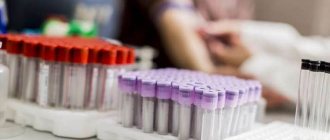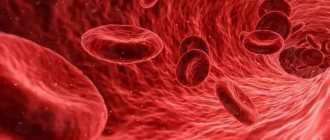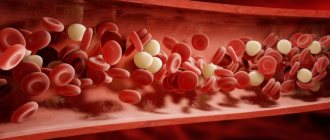Home / Cancer Treatment / Blood Cancer Treatment
- Doctors
- Tomotherapy
- Reviews
- Cost of treatment
- Classification
- Symptoms
- Diagnosis and treatment
In layman's terms, blood cancer is a malignant neoplasm that primarily affects hematopoietic tissue and leukocytes circulating in the blood. In official medical terminology, such diseases are called leukemia or leukemia. Sometimes blood cancer is called lymphoma, but this is not entirely true, since in this case bone marrow damage is only a consequence of metastasis.
Malignant degeneration in leukemia occurs at the level of stem cells. The processes of pathological division and cloning of atypical cells, suppression of natural cell death lead to the replacement of normal blood cells with tumor ones.
Reviews
Thank you very much to the Reavit staff for their well-organized work, kind, friendly attitude, and professionalism.
Sabirova N.A.
September 27, 2021
All reviews
Rushana's story, lung cancer
“Hello, my name is Rushana, I live in the city of Kazan and I ended up in this center, like many people, probably unexpectedly. Because for most of our lives we do not imagine that we might encounter anything else, that there might be some serious difficulties in our lives that we have not yet overcome.
All stories
Life expectancy with cancer
Life expectancy is determined for an individual patient or group of patients; it is either the exact or average period that the patient managed to live from the starting point of diagnosis or completion of some special treatment. In addition to the oncological process itself, the life expectancy indicator is influenced by age, gender, physical condition and concomitant diseases, as well as genetics and previous lifestyle, anti-cancer therapy, that is, individual variables. It is possible to transpose the standard life expectancy indicator to a specific person with very large reservations.
Is it possible to rely on the life spans indicated in the results of clinical trials of methods and drugs? It is imperative to take into account that at the end of clinical trials, the process of monitoring patients often ends, funding has ended and the participants “go about their business”, and to evaluate the result of the experiment they resort to a mathematical calculation of expected survival. It is clear that the estimated life expectancy of patients derived by statisticians will not always reflect reality.
Prices
| Name of service | price, rub. | Unit measurements |
| Consultation with an oncologist and radiotherapist | 1 500 | PC. |
| Consultation with a pediatric oncologist | 0 | PC. |
| Repeated consultation with specialists | 500 | PC. |
| Primary topometry on a specialized computed tomograph | 15 000 | procedure |
| Repeated topometry on a specialized computed tomograph | 7 000 | procedure |
| Primary dosimetric planning of radiation therapy (tomotherapy) | 20 000 | PC. |
| Repeated dosimetric planning of radiation therapy (tomotherapy) | 7 000 | PC. |
| Radiation therapy (tomotherapy), including IMGRT (*) | 315 000 | well |
| Radiation therapy (tomotherapy) stereotactic radiofrequency surgery (*) | 315 000 | well |
| Accompanying drug therapy: intravenous administration in the treatment room (excluding the cost of medications) | 1 000 | procedure |
| Accompanying drug therapy: intramuscular administration in the treatment room (excluding the cost of medications) | 200 | procedure |
| Topometric marking | 750 | procedure |
| Conducting a study of the radiation therapy plan using absolute dosimetry on a specialized phantom “Cheese Phantom Accuray” | 15 000 | procedure |
| Carrying out the quality assurance (QA) procedure for the radiation therapy plan on the specialized phantom “PTW Octavius” | 30 000 | procedure |
The type of radiation therapy and the number of sessions of the course are determined by the medical commission individually for each patient based on the location, nosology of the tumor and taking into account the medical history.
Free online consultation
Sign up
Basics of classification
Initially, leukemia was divided into “acute” and “chronic”, meaning not the nature of the disease, as is customary in other areas of medicine, but the expected life expectancy of the patient. In the latest classifications, leukemia is distinguished according to two main criteria:
- Cellular phenotype is the totality of all processes occurring in a cell.
- Degree of differentiation at the time of clinical manifestations. All the various cells of the body have a common origin from stem cells. As they mature, they gradually acquire a narrow specialization. The higher the degree of differentiation, the more different the cell is from its stem predecessors.
Thus, there are 4 main leukemias, each of which is divided into many subtypes:
- Acute lymphocytic leukemia is the most common cancer in children. Represented by immature and abnormally long-lived lymphocytes.
- Chronic lymphocytic leukemia. More common in adulthood and old age. Presented by atypical, but morphologically mature lymphocytes.
- Acute myelocytic leukemia is the most common leukemia in adults and can be secondary. It is represented by precursor cells of the myeloid series - granulocytes and monocytes.
- Chronic myelocytic leukemia. It occurs at any age and is represented by a large number of immature cells of the myeloid series.
A separate group includes the so-called myelodysplastic syndromes - a whole group of diseases in which there is abnormal development (dysplasia) of progenitor cells of various hematopoietic lines and a deficiency of mature formed elements in the blood. Patients with these diseases have an increased risk of developing acute myeloid leukemia, but most patients will not.
Different types of leukemia have their own characteristics that determine the clinical picture, course of the disease, and prognosis for life. Blast crises are possible, in which the disease acquires the characteristics of an acute pathology and threatens the patient’s life.
Symptoms before death
Symptoms depend on the stages that patients go through. The preagonia stage is a condition caused by severe disturbances in the functioning of the central nervous system, the skin turns pale, and the skin becomes blue. The patient is depressed physically and emotionally. Blood pressure drops.
The agony stage is the last stage before death in patients. The patient experiences severe oxygen starvation, which leads to cessation of blood circulation and respiratory arrest. The agony can last up to 3 hours.
The stage of clinical death - the body ceases to function, the last metabolic processes take place in the cells of the body. The stage lasts several minutes and ends with the biological death of the patient.
Causes and risk factors
The true causes of most leukemia are still unknown. There are factors that may increase the risk of developing the disease:
- penetrating radiation;
- the effect of certain chemical compounds, for example, benzene;
- treatment with certain cytostatics (chemotherapy);
- Epstein–Barr virus infection;
- chromosomal disorders, including Down syndrome;
- immunodeficiency states.
It should be noted that although these factors increase the risk of developing leukemia, the vast majority of people do not.
Causes
The main reasons due to which this oncopathology may occur are:
- genetic predisposition;
- severe viral diseases that led to weakening of the body;
- ionizing radiation;
- medications, long-term use of antibiotics, chemicals (polymer materials, paints, varnishes, household chemicals);
- frequent stress.
But modern diagnostics show that oncology may have nothing to do with risk factors. There are cases when diagnostics revealed pathology in a person who had no apparent reason for the development of the disease.
Clinical appearances
Acute leukemia usually develops quite rapidly, and the first symptoms become apparent several weeks before diagnosis. Disruption of normal hematopoiesis leads to such common symptoms of leukemia as anemia and increased bleeding. At the same time, other manifestations of pathology are nonspecific and do not always allow one to objectively suspect it. These are weakness, malaise, fever, weight loss. Usually the cause of fever is unknown, although in some cases a deficiency of granulocytes contributes to the rapid development of bacterial infections.
Increased bleeding is manifested by a tendency to form hematomas, petechial rashes, nosebleeds, and menstrual irregularities. Damage to the bone marrow can cause bone pain, which is especially common in children with acute lymphocytic leukemia. Signs of infiltration by atypical cells of certain organs may appear: enlargement of the liver, spleen, lymph nodes.
Chronic lymphocytic leukemia progresses slowly. Often they have no clinical manifestations at all or are accompanied by nonspecific symptoms - slight fever or unmotivated weakness. Clinical manifestations in the early stages of chronic myeloid leukemia are similar, but after a certain period of time, excessive accumulation of tumor cells occurs and the disease enters the blast crisis phase with a sharp deterioration in the patient’s condition.
Diagnosis of leukemia in the oncology center
Diagnosis of leukemia in the oncology center, located at 2nd Tverskoy-Yamskaya Lane, is carried out in several stages:
- initial examination by a doctor with medical history;
- general and biochemical blood test;
- taking tests using modern diagnostic techniques: MRI, ultrasound, PET/CT, radiography, scintigraphy, SPECT.
One of the most informative diagnostic methods is bone marrow puncture (immunohistochemistry of punctate, cytochemical and cytogenetic analyses).
Highly qualified oncology specialists use the latest diagnostic equipment, which guarantees high diagnostic accuracy and safety for patients.
Forecast
Significant differences in the nature and course of leukemia determine a different overall prognosis of the disease and the effectiveness of treatment.
Acute lymphocytic leukemia
Remission after standard therapy in children occurs in more than 95% of cases. Moreover, the five-year survival rate without signs of the disease, which can be regarded as recovery, in children reaches 75% or more. In adults, these figures are 70–90% and 30–40%, respectively.
Acute myeloid leukemia
Remission can be achieved in 50–85% of patients. In 20-40% of cases, a long relapse-free period is noted. The latter indicator increases slightly during intensive chemotherapy or stem cell transplantation.
Chronic lymphocytic leukemia
In the absence of treatment, patients in the early stages of the disease live on average 5-20 years, in later stages - 3-4 years after diagnosis. Shorter life expectancy is associated with rapid development of spinal cord insufficiency. A cure for this pathology is usually impossible, and the goal of therapy is to increase life expectancy and improve its quality.
Chronic myeloid leukemia
Before the advent of targeted cytostatics, and in particular imatinib, up to 10% of patients died within two years after diagnosis. Today, if treatment is started in the chronic phase, the five-year survival rate exceeds 90%. The main danger of this type of leukemia is blast crises, after which the vast majority of patients die within a fairly short time.
Factors influencing the life span of cancer patients
The effectiveness of therapy does not always affect the life expectancy of patients; chemotherapy for melanoma can reduce the manifestations of the disease and delay the development of relapse after surgery, but does not affect the average life expectancy. In a large group, the average number of months lived is no more than the life expectancy of those left without treatment, but each person lives his or her own term and life, some for 3 years, some for six months, and some for one and a half years.
With age, the survival prognosis only worsens, and young women live longer because they respond better to treatment and, accordingly, for both populations, the average life expectancy is just a number that does not affect a specific fate.
It is clear that the average life expectancy does not reflect individuality; it is a marker of the effectiveness of modern treatment approaches, intended for organizers of oncological care and research teams.
In each specific case, an individual life prognosis is calculated for the patient, based on which a treatment program is selected. For all malignant diseases the following is determined:
- cancer histology, some variants are initially considered clinically unfavorable;
- the degree of aggressiveness of the disease, which is noted in the pathomorphological report as differentiation, the prognosis is worsened by low and undifferentiated;
- the prevalence of the process in the form of the stage of the disease;
- the number of lymph nodes affected by metastases indicates the spread of cancer cells beyond the primary tumor;
- perineural and lymphovascular invasions - cancer cells in places where neurovascular bundles pass also indirectly indicate the spread of the process in the body;
- certain genes and their mutations, sex hormone receptors help to more accurately select medications and also reflect the degree of malignancy.
It is difficult to say how objectively these characteristics reflect life prospects. For example, acute leukemia is much more aggressive than the morphologically more favorable cutaneous lymphoma, however, with lymphoma the immediate effectiveness of treatment and the likelihood of cure are lower.
Diagnostics
Laboratory tests play a key role in making a diagnosis and differential diagnosis:
- General analysis and peripheral blood smear. A decrease in hemoglobin levels and thrombocytopenia, impaired differentiation of leukocytes, and the appearance of blast cells can be noted. The content of white blood cells can range from 1*109/l to 200*109/l.
- Coagulogram. Various disorders in the blood coagulation system are possible, especially with promyelocytic leukemia.
- Bone marrow aspiration biopsy. The biopsy specimen reveals a high content of blasts - up to 95%.
- Immunophenotyping is a laboratory method that allows you to determine the type of leukemia, which is extremely important for determining treatment tactics.
- Cytogenetic study. It is carried out to determine chromosomal abnormalities that could lead to the development of the disease.
- Blood chemistry. Allows you to determine the general condition of the body, for example, detect kidney or liver failure.
In addition, to detect infiltration by cells of various organs, radiation diagnostic methods are used: ultrasound, CT, radiography.
Stages of blood cancer:
Stage 1 – an increased number of granular leukocytes is observed in the blood.
Stage 2 – rapid division of abnormal cells, during which tumor mass accumulates in the blood.
Stage 3 – rapid growth of the tumor mass. Blast cells travel with lymph and blood throughout the body and form metastases in nearby organs.
Stage 4 – the appearance of malignant tissues in various organs.
Treatment
Treatment tactics for different types of leukemia may differ significantly. Main treatment methods:
- Chemotherapy. It is used to achieve remission and its consolidation in almost all types of leukemia.
- Monoclonal antibody therapy. A relatively new method of targeted therapy that provides selective destruction of tumor cells. Used for acute and chronic lymphocytic leukemia.
- External beam radiation therapy. An auxiliary method of treatment, more in demand for damage to the central nervous system or for palliative purposes in chronic lymphocytic leukemia.
- Hematopoietic stem cell transplantation. A highly effective, but not always available, treatment method that can be used for most leukemias.
In each case, the doctor is faced with the task of choosing the most optimal tactics depending on the type of leukemia and its stage. For example, aggressive management of chronic myeloid leukemia is sometimes more dangerous for the patient than insufficient treatment.
FAQ
How much does a course of treatment cost?
A course of treatment together with pre-radiation preparation costs 315,000 rubles. It is possible to arrange an installment plan for the entire period of treatment.
Is there online consultation?
For residents of other regions, as well as for those who find it difficult to visit a doctor, our center provides the opportunity for free online consultation.
Documents required for online consultation?
To receive advice on the possibility of receiving tomotherapy, you need to send us all your medical records and examinations, including a histological report. A referral for a free consultation is not required.
Is treatment possible for children?
Tomotherapy is most favorable for the treatment of children, since radiation therapy is carried out using a gentle method, without affecting the healthy organs and tissues of the developing child.
At what stage can radiation therapy be used?
In modern oncology, the possibilities of radiation therapy are used very widely at any stage. However, each patient requires an individual approach, since the choice of tactics and treatment plan depends on many factors: location of the tumor, concomitant diseases, age and general condition of the patient. Therefore, to obtain information about the possibility of treatment, it is necessary to consult a radiotherapist.
Date of writing: 09/07/18 Date of update: 07/24/20 Checked by: Oleg Vitalievich Morov
Benefits of onco
The success of oncology treatment greatly depends on the level of the clinic. And it’s not just about the professionalism of doctors and specialists conducting diagnostics. All therapeutic procedures must be performed using modern and high-tech medical equipment. The same applies to devices on which diagnostics are carried out. The data obtained with their help must be as accurate as possible so that the doctor can determine the location of the lesion and the stage of oncological pathology. And don’t forget about patient comfort. Diagnosis and treatment of oncological diseases takes a lot of time. Patients often have to spend the whole day within the walls of a medical facility, and some patients are undergoing inpatient treatment. Therefore, it is important that the environment and atmosphere be as favorable as possible. Onko took into account both his own 30 years of experience and the experience of foreign medical institutions. This allows us to diagnose cancer tumors and treat cancer patients with maximum efficiency, safety and comfort. See for yourself:
- Each of our doctors is a highly qualified specialist with many years of experience both in Russia and in hospitals in the USA, Europe and Israel. We employ leaders of domestic medicine, as well as competent international consultants.
- Diagnostics and therapeutic procedures are carried out in beautiful and cozy rooms. We have decorated our departments in a stylish design so that the interior looks as little as possible like a hospital room. Also for patients and their accompanying people there is a café and a restaurant on the roof with panoramic views of the city.
- High safety and quality levels have been repeatedly confirmed by numerous certificates and awards. We carry out our activities in strict accordance with domestic and international standards, which allows us to minimize side effects and significantly increase the chances of recovery.











